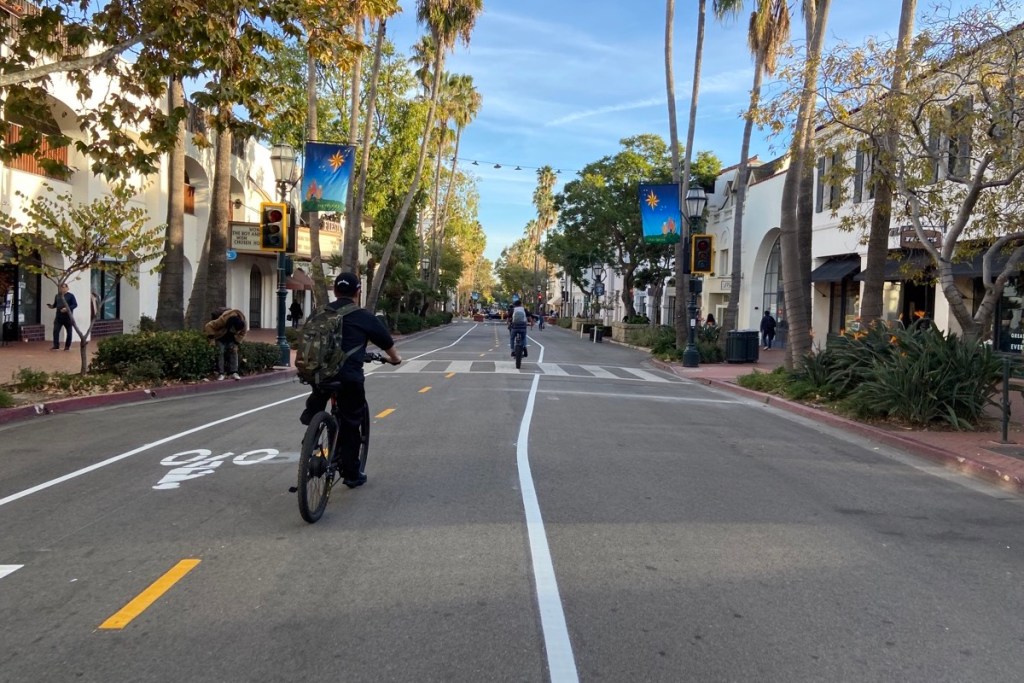Despite large investments in bicycle infrastructure (paths, lanes and tracks), Vision Zero, and bicycle purchases following COVID, bicycle ridership is decreasing and injuries are increasing in Santa Barbara – and much of the rest of the United States.
Ridership. The number of people bicycling to work has fallen to the lowest levels since statistics were first collected in 2009. The downward trend began in 2015, long before COVID and the increase in people working from home. Rather, early in covid, bicyclists joyously announced a surge in ridership.
The fall in commuting to work does not appear to be accounted for by either the increase in people working from home. According to Eco-counter (the company that makes bicycle counters), compared the year before COVID (2019), the graph below shows surge in 2020, and a fall to below baseline in 2023. In the West Coast of the United States, cycling decreased 3% from 2022 to 2023.
Injuries surged to 121 in 2023, the second highest number on record.
Hot spots for injuries are almost everywhere, even a few on the car-free parts of State Street. (Yes, sometimes bicyclists are responsible for bicycle injuries).
Fortunately, bicycle associated fatalities have not increased in the city of Santa Barbara (about one every other year) or county of Santa Barbara (about 2 deaths every year). However, nationally, the 1,105 cyclist deaths in 2022 was the highest ever reported. The characteristics of Santa Barbara’s bicycle death numbers are generally are similar to the national profile: male, 55 and older, and some with alcohol or substances in their systems.
The decrease in bicycle ridership in Santa Barbara city is mirrored in the county, California, and many parts of the United States. There has been a precipitous fall in the bicycling bastion of Portland Oregon. New York City is the only major metropolitan area showing a sustained increase in ridership.
Perhaps in part due to these disappointing trends, People for Bikes, Trek Bicycle’s nonprofit arm, stopped counting ridership and injury data, now focusing only on the miles and utility of bicycle paths. In the its latest analysis, the City of Santa Barbara ranked 128 out of 1483 cities in the United States, 23 out of 173 in California, and 32 of 235 coastal cities in the Western U.S.
What should we do? Clearly increasing bicycle infrastructure has had no effect in Santa Barbara, although it may have elsewhere. Constantly referring to Europe’s success in incresing ridershiip and decresing deaths has also not accompanished anything. In much of Europe, in all bicyclist vs car collision, the car automatically has to pay the victim. Try that out in the Santa Barbara courts!
The bicycle movement must understand the complexity of our country’s automobiles addiction. As much as I love Santa Barbara’s bicycle lanes, our many bike paths have done nothing to increase ridership or safety.
What can bicyclists advocated do? They need to figure out ways of discouraging automobile use other than building more back paths. To show that bicyclists are changing, they could stop opposing helmet laws for adults. (These laws have been shown to be save rider’s brains and government’s money and do not discourage bicycling.
They could combate climate change in additional ways on the United Nations list of 10 actions for a healthy planet: stop eating meat, sell their cars and stop using airplanes. Those of us living in a higher income countries (presumably everyone reading this) should consider having fewer children.
To my fellow bicyclists: stop complaining and do something else to help. The bicycling in Santa Barbara may not be the best in the West, but it is pretty good.

